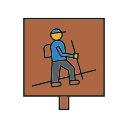Mastering the Layering System
Start with moisture-wicking merino or synthetic tops and bottoms, flat seams, and a snug fit that moves sweat before it chills you. On the Annapurna Circuit, swapping a drenched tee for a dry spare during a rest stop stopped shivers instantly. What base layer fabric never fails you?
Mastering the Layering System
Carry a high-loft midlayer—down for warmth-to-weight, or synthetic for resilience in damp, stormy spells. A belay-style puffy with 800-fill down kept my hands nimble at a Cotopaxi sunrise. Size it to fit over other layers. What temperature rating do you trust above tree line?
Mastering the Layering System
A hardshell with durable waterproofing, sealed seams, pit zips, and a helmet-compatible hood blocks spindrift and screaming wind. Softshell pants breathe on the climb, hardshell pants protect in squalls. After a gusty ridge coated us in ice pellets, an intact DWR saved precious heat. Your go-to shell?




